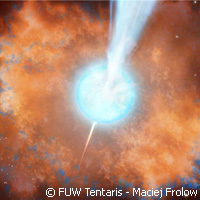Astronomers find piece in dark energy puzzle
The fast expansion of the Universe is triggered by dark energy. But no one has been able to shed light on what is the nature of dark energy... until now. Enter a team of astronomers from Italy and Poland that successfully developed a method to measure the largest distances in the Universe. They identified that gamma-ray bursts, what experts call power cosmic explosions, play a significant role in the nature of dark energy. Astronomers from the Faculty of Physics, University of Warsaw (FUW) and the University of Naples Federico II used their latest creation to verify models of the structure of the Universe containing dark energy. 'We are able to determine the distance of an explosion on the basis of the properties of the radiation emitted during gamma-ray bursts,' explains Professor Marek Demianski of FUW. 'Given that some of these explosions are related to the most remote objects in space that we know about, we are able, for the first time, to assess the speed of space-time expansion even in the relatively early periods after the Big Bang.' More than 12 years ago, astronomers found during an analysis of the brightness of Type Ia supernovae that the most remote explosions seemed to be weak. Binary systems are the niche for Type Ia supernovae. The white dwarf is one of the stars, and is the remains of an evolutionary cycle of stars similar to the Sun. The white dwarf 'receives' the droppings of the hydrogen-filled external layers of the second star of the system that expands after it enters the red giant phase. So the white dwarf grows in mass. When the white dwarf reaches 1.4 solar masses, it explodes and tears apart. Because the conditions that lead to the explosion do not change, Type Ia supernovae always release around the same amount of energy each time. Astronomers are able to measure distances in space because of this property. The researchers suggest that the Type Ia supernovae are more distant than initially thought because of their fainter brightness. An interesting observation was that the expansion did not slow down, rather the Universe accelerated. So a new form of mass energy, what the experts call dark energy, had to be included in the theory in order to reconcile the earlier models of the Universe with the observations. They say the measurements show that a huge amount of dark energy - around 20 times more than the amount of mass-energy related to the world that is accessible to human senses - exists. Says Professor Demianski, 'Overnight, dark energy became, quite literally, the greatest mystery of the Universe.' The team notes that looking at the dark energy's density in different periods after the Big Bang can help researchers determine which model should be used. Dark energy is associated with the property of space-time if its density is constant, while the density should change if the acceleration of the Universe is triggered by a scalar field. But evaluating the changes in dark energy's density following the Big Bang is complex, and it is important that one knows how to measure the distance to very remote objects. Hence the use of gamma-ray bursts to measure these large distances, according to the astronomers. The gamma radiation emitted is so intense that it is also possible to observe objects that exploded 400 million years after the Big Bang. 'We knew the distance to the galaxy and we also knew how much energy of the burst reached the Earth. This allowed us to calibrate the burst, that is to say, to calculate the total energy of the explosion,' Professor Demianski explains. 'We cannot provide a physical explanation of why certain properties of gamma-ray bursts are correlated but we can say that if registered radiation has such and such properties, then the burst had such and such energy. This allows us to use bursts as standard candles, to measure distances.'For more information, please visit:Faculty of Physics, University of Warsaw (FUW):http://www.fuw.edu.pl/University of Naples Federico II:http://www.international.unina.it/
Countries
Italy, Poland



